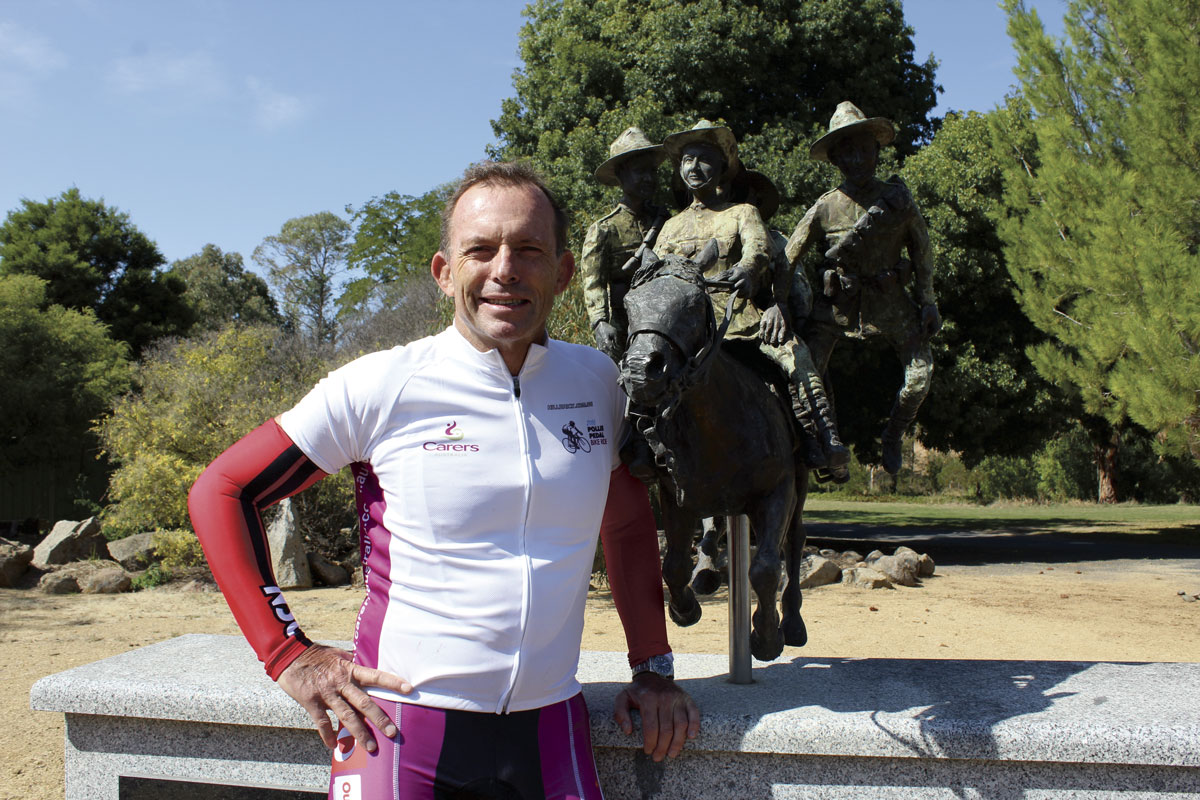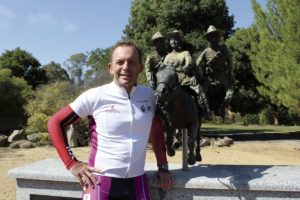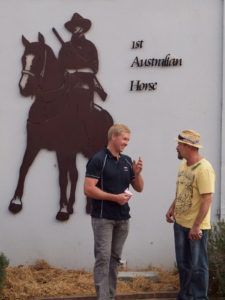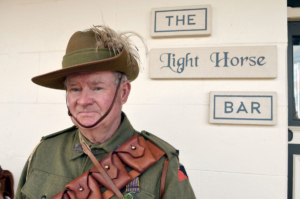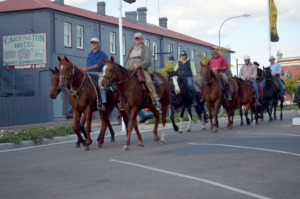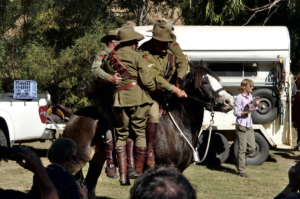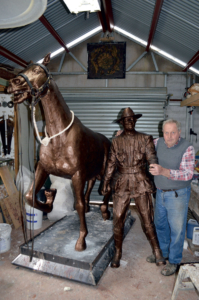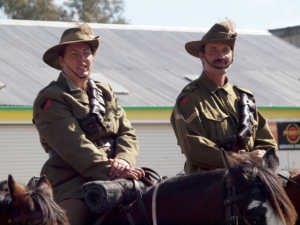Former Prime Minister Tony Abbott stopped at the Terracotta Restaurant in Murrumburrah during the Pollie Pedal in early April this year. He was invited by the staff at The Twin Town Times for a quick history lesson on the famous horse and rider, whose miniature sized monument will be unveiled in life size, 6 August in Murrumburrah. Abbott was interested to know the history of the story and even joked that the caption of the photo for the local paper may be “Two bastards”. He was a very good sport.
The one hundred year anniversary of the World War 1 battle of Romani will be remembered on 6 August 2016, in the small township of Harden Murrumburrah which is the home of the First Australian Horse and situated between the nation’s capital, Canberra, and New South Wales’ unofficial regional capital, Wagga Wagga, on the Burley Griffin Way.
Part of the Light Horse Memorial in Murrumburrah.
The aptly named Light Horse Hotel in Murrumburrah will host the unveiling of a life-size sculpture commemorating war horse Bill the Bastard, his rider Major Michael Shanahan and the four Tasmanian soldiers they rescued.
Barry McCormack, member of the Harden Murrumburrah Light Horse Troop on the verandah of the Light Horse Hotel in Murrumburrah in 2014.
On 30 August 1897, the very first call up muster for enrolments in the First Australian Horse took place at Harden Murrumburrah. Advertisements were placed in local papers inviting men to join up. They were promised comradeship, sport and good fun. Of the 80 who arrived on the day and tried out, 60 local men were picked to join up as volunteers. They had to prove themselves as competent riders and had to provide their own horses. Many of these horse were home breeds or descendants of high country brumbies. Many of these horses, along with their riders, never returned from their conflict in war.
The anniversary on Saturday, 6 August marks 100 years since a man and a horse did the unthinkable and wrote themselves into Australia’s history. The man was Major Michael Shanahan, a horse whisperer before his time. The horse was Bill the Bastard, aptly named for the fact that he was almost unrideable except for when Shanahan was on his back. Shanahan was from Roma in Queensland and left Australia on 24 September 1914 to fight in World War l. His feats of bravery, with Bill, earned him the Distinguished Service Order for conspicuous gallantry in action.
Harden Murrumburrah Light Horse Troop members practising for ANZAC day 2014.
Shanahan and Bill combined to do what no other partnership seemed able to achieve. It was an understanding by man and beast of respect, toughness and ability of rider and horse. Bill the Bastard and Shanahan are as much a part of Australian history as Simpson and his donkey.
The story of Shanahan and Bill is one of legend. Before they met each other Bill was used to carry mail for the Australian soldiers. Bets were laid on whether the rider would be able to ride him or not for the journey, whilst under gunfire from Turkish positions. The reason for betting wasn’t that the riders would be shot, but whether they could stay on a horse renowned for bucking and leaving his mount rolling in the Egyptian sands. Those who bet on Bill were normally rewarded with a profit.
Bill wasn’t just any horse; he was a 17 hand Waler, as tall as black Caviar and with a mixture of breeding which made him perfect for his role as a cavalry horse. The Waler shares much of the same breeding as the wild horses of Australia known as the brumbies. They are often a mixture of Thoroughbred, Arab, Cape horse, Timor pony with some Clydesdale or Percheron in the mix to add bulk. Unfortunately the 100 year anniversary of Romani is to fall just a few days after horsemen from the Snowy Mountains area and horse lovers from all over Australia will march on New South Wales’ Parliament house to defend the brumbies, i.e. on 2 August.
A draft management plan is currently on exhibition which, if passed by the New South Wales government, will see brumby numbers culled to 600. National Parks’ figures estimate that there are currently 6,000 brumbies, a figure which is disputed by brumby advocates who estimate herd numbers as far fewer. A number of long-term residents of the High Country see this plan as the death knell for the horse which took our young men and women to war, is on our $10 note and is a part of our history and heritage. Funnily enough our most successful provincial Rugby side uses the brumby as their mascot, yet has remained silent on the issue.
Author of Bill the Bastard Professor Roland Perry, who will be attending the unveiling as guest speaker, said,
“Bill was massive. He had power, intelligence and unmatched courage. In performance and character he stood above all the other 200,000 Australian horses sent to the Middle East in the Great War. But as war horses go he had one serious problem. No one could ride him but one man, Major Michael Shanahan. Some even thought Bill took a sneering pleasure in watching would-be riders hit the sand in the Egyptian desert. Bill the Bastard is the remarkable tale of a bond between a determined trooper and his stoic but cantankerous mount. They fought together. They depended on each other for their survival. And when the chips were down, Bill’s heroic efforts and exceptional instincts in battle saved the lives of Shanahan and four of his men. By September 1918, Bill the Bastard was known by the entire Light Horse force, who used his name not as an insult, but as a term of endearment. Bill had become a legend, a symbol of the courage and unbreakable will of the ANZAC mounted force. There was no other horse like Bill the Bastard.”
The fighting at Romani continued for three days and was in the balance. It was at night that an Australian legend was born. Shanahan and Bill were charging up and down the Australian line keeping their men within their ranks. To understand the power of this horse, Bill went for five or six hours when other horses lasted only 30 minutes. One General exhausted 17 horses during the night.
Shanahan and Bill found four Tasmanian soldiers stranded next to their dead horses and under gun fire. Bill and Shanahan were no longer man or horse – they were one. They didn’t have time to fear or think about how tough the job was. Bill’s ears laid back and he charged in towards the helpless Australian soldiers. Shanahan said to them “Get up on Bill, get up! One on each stirrup, two on the back, we will get out.” The horse, which three months earlier was unrideable, took the five men out of danger and cantered them over one kilometre back to safety.
Members of the Harden Murrumburrah Light Horse Troop on ‘Poppy’ on ANZAC day 2016, owned by Dave and Jan Young. ‘Poppy’ is a part Clydesdale used by the group to provide Carl Valerius with the photographs he needed to commence the sculpture of Bill and Shanahan and the rescued soldiers.
Shanahan wasn’t finished yet; he turned Bill around and went back into battle for another hour and a half. Shanahan was badly wounded in the left leg and went on fighting until he collapsed on the horse. Bill very gently took his master back to base. If Shanahan had been on a frightened horse it would have no doubt lost him in the sand and left him for dead. Bill saved his mate’s life.
Shanahan had his leg amputated. Despite being officially retired after the battle, Bill would still help out by carrying machine guns or leading the line. He was seen as a symbol of strength to the troops.
Dianne Valentine spoke fondly of her Uncle ‘Mick’ recently; she said, “He was a remarkable man. When I was a child he made me dolls’ furniture out of old packing cases and would slide around my parents’ (and grandmother’s property – his sister) on a hessian bag strapped to his waist and trim all the grass around the fence line with a pair of old shears. Something which would take him all day. ” Descendants of Shanahan will be making the trek to Harden Murrumburrah for the unveiling, many from Queensland.
Only a few words need to be said for the hairs on the back of one’s neck to stand up, and a shiver to run down the spine before the eyes well up. “There was movement at the station for the word had got around that the colt from Old Regret had got away.” The most famous work of our literary legend Banjo Paterson was first published on 26 April 1890. It went on to become intertwined with the ideas and feelings which shaped a young nation yearning for an identity.
The most amazing part of this story is that Paterson was himself the man whom Shanahan asked if he could enter the battle with Bill. Paterson had carved out an impressive military career in World War l and had quickly risen to the role of Major. If Hollywood had scripted it, the viewers would say it was a bit rich.
Carl Valerius is no stranger to what many in his field would call difficult. The lifelong stonemason and sculptor doesn’t shy away from his work. The 71 year old has spent the past few months crafting the masterpiece of Bill and his five riders. Carl will turn 72 on 9 August. His wife Faye said “He is supposed to be retired but he is doing it for the soldiers and their memory; he is doing it for the love of it.”
Valerius brought in local vet Graham Taylor to advise him on the subtle lines and features of the horse, began sculpting the horse’s head from clay and then the body. He finally embarked on sculpting the five soldiers, one of which is fashioned on the face of Cheryl Francis’ grandfather who was a light horse member and war veteran. The Francis family has recently taken over the lease of the Light Horse Hotel, moving from Marulan near Goulburn earlier this year.
Creator Carl Valerius with one of the Five soldiers who will be mounted on Bill for the unveiling.
Cold days and nights in front of Carl’s fire in his workshop, as well as his own funds, have culminated in the sculpture. Carl won’t reveal what he has spent, however we can only guess it’s tens of thousands of dollars in man hours and materials.
The unveiling of the life-size sculpture of Major Michael Shanahan and Bill the Bastard will occur at 1:00 pm on Saturday, 6 August at the Light Horse Hotel in Murrumburrah. Make sure you don’t miss this historic event which commences at 11:30 am with music and barbecue, and proceeds to go to Legacy. A dramatic soundtrack with music, lighting and gunfire will accompany the unveiling. A dinner will be held, later on in the evening, which is sold out. Guest Speaker will be Professor Perry.
“There is something about the outside of a horse that is good for the inside of a man.”
Light Horse members, wife and husband, Jan and Dave Young.
Written by Matthew Stadtmiller, Editor. Email: editorial@twintowntimes.com.au
Mob: 0408 00 4975 Photos by Matthew Stadtmiller – please credit.

